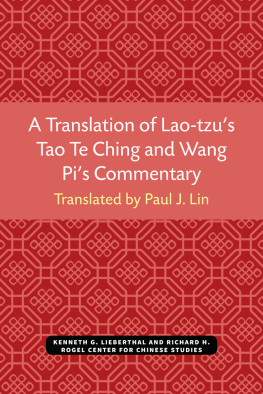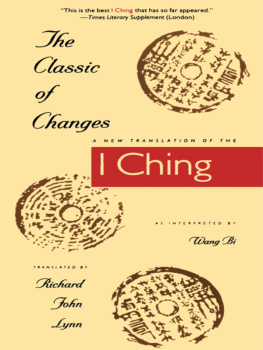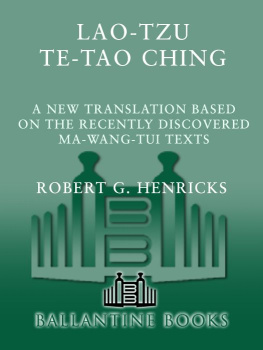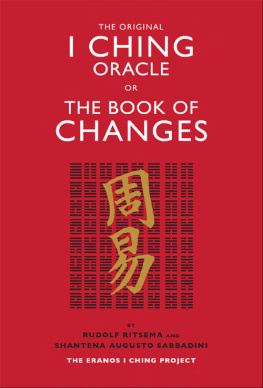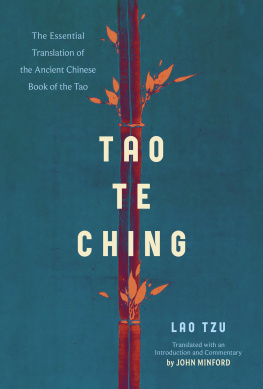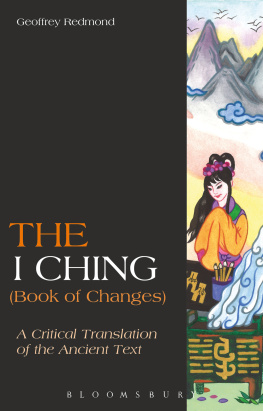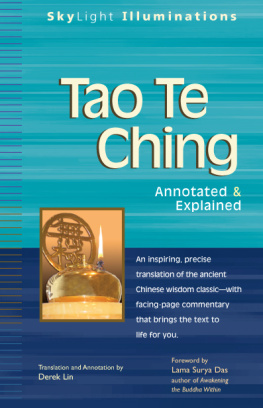Paul J. Lin - A Translation of Lao Tzu’s Tao Te Ching and Wang Pi’s Commentary
Here you can read online Paul J. Lin - A Translation of Lao Tzu’s Tao Te Ching and Wang Pi’s Commentary full text of the book (entire story) in english for free. Download pdf and epub, get meaning, cover and reviews about this ebook. year: 2020, publisher: Kenneth G. Lieberthal and Richard H. Rogel Center for Chinese Studies, genre: Religion. Description of the work, (preface) as well as reviews are available. Best literature library LitArk.com created for fans of good reading and offers a wide selection of genres:
Romance novel
Science fiction
Adventure
Detective
Science
History
Home and family
Prose
Art
Politics
Computer
Non-fiction
Religion
Business
Children
Humor
Choose a favorite category and find really read worthwhile books. Enjoy immersion in the world of imagination, feel the emotions of the characters or learn something new for yourself, make an fascinating discovery.
- Book:A Translation of Lao Tzu’s Tao Te Ching and Wang Pi’s Commentary
- Author:
- Publisher:Kenneth G. Lieberthal and Richard H. Rogel Center for Chinese Studies
- Genre:
- Year:2020
- Rating:5 / 5
- Favourites:Add to favourites
- Your mark:
- 100
- 1
- 2
- 3
- 4
- 5
A Translation of Lao Tzu’s Tao Te Ching and Wang Pi’s Commentary: summary, description and annotation
We offer to read an annotation, description, summary or preface (depends on what the author of the book "A Translation of Lao Tzu’s Tao Te Ching and Wang Pi’s Commentary" wrote himself). If you haven't found the necessary information about the book — write in the comments, we will try to find it.
Paul J. Lin: author's other books
Who wrote A Translation of Lao Tzu’s Tao Te Ching and Wang Pi’s Commentary? Find out the surname, the name of the author of the book and a list of all author's works by series.
A Translation of Lao Tzu’s Tao Te Ching and Wang Pi’s Commentary — read online for free the complete book (whole text) full work
Below is the text of the book, divided by pages. System saving the place of the last page read, allows you to conveniently read the book "A Translation of Lao Tzu’s Tao Te Ching and Wang Pi’s Commentary" online for free, without having to search again every time where you left off. Put a bookmark, and you can go to the page where you finished reading at any time.
Font size:
Interval:
Bookmark:

THE UNIVERSITY OF MICHIGAN
CENTER FOR CHINESE STUDIES
MICHIGAN PAPERS IN CHINESE STUDIES
NO. 30
A TRANSLATION OF LAO TZUS TAO TE CHING AND WANG PIS COMMENTARY
by
Paul J. Lin
Ann Arbor
Center for Chinese Studies
The University of Michigan
1977
Open access edition funded by the National Endowment for the Humanities/Andrew W. Mellon Foundation Humanities Open Book Program.
ISBN 0-89264-030-8
Copyright 1977
by
Center for Chinese Studies
The University of Michigan
Printed in the United States of America
ISBN 978-0-89264-030-0 (paper)
ISBN 978-0-472-12743-6 (ebook)
ISBN 978-0-472-90138-8 (open access)
The text of this book is licensed under a Creative Commons Attribution-NonCommercial-NoDerivatives 4.0 International License: https://creativecommons.org/licenses/by-nc-nd/4.0/
CONTENTS
by Ssu-ma Chien
by Ho Shao
This translation was begun in 1968 as research in an area of great personal interest. As a Chinese with an undergraduate major in Western literature and a graduate concentration in English and Philosophy, I was particularly interested in bringing these two cultural worlds together in a philosophical setting. As professor of Non-Western Philosophy and Chinese Philosophy at Southern University, I found a tremendous source of input from my students. Many of them expressed a keen interest in studying the works of Lao Tzu, although warned beforehand that such an endeavor required a rigorous examination of ideas foreign to the Westerner in thought and structure. One who drank deeply of the sweet and the bitter in her intense study of Lao Tzu was the late Ms. Lois A. Miller.
In December 1974, in the course of sending seasons greetings to many of my friends and former professors, I attached questionnaires focusing on certain problem areas of the text of the Tao Te Ching, of Wang Pis commentary and of Ho Shaos biography of Wang Pi. Not only were the responses enthusiastic, but if one friend had doubts about answering a question, he in turn sent letters to his friends and professors asking for their opinions. These respondents covered a wide geographic area and included both Chinese and non-Chinese, and their answers could easily become the basis of another entire book. Their responses not only show the universality of scholarship and interest in this ancient metaphysical philosophy, but also have inspired me to dig deeper and think harder to reconcile differences in interpretation. Having troubled so many friends and friends of friends and made demands on their valuable time and energy, I wish I could acknowledge each of them here. But since they are too numerous to be mentioned in this limited space, I will simply say that without their contribution, the value of this work would have been greatly reduced. I would like to thank, however, the following people who guided me in their particular areas of expertise: Professors K. H. Chan, Constant C. C. Chang, Chen Tsu-wen, Chow Tse-tsung; Charles C. L. Fan, Charles Wei-hsun Fu, Ho Chiew-tsung, Hsiao Chun-po, Hsu Chia-pi, Louis S. Illar, Jao Tsung-i, Kao Yueh-tien, Li Tche-houa, Lin Wen-chouh, Liu Shu-hsien, Wang Chao-nan Ho, Wang Fan-yu, Wang Teh-chao, Wong Yuk, Wu Yi, Yang Chialo, Yang Lien-sheng, and Yen Lingfeng. My appreciation also goes to the administration of Southern University for providing much-needed facilities and clerical help and to Dr. Huel D. Perkins, Dean of the College of Arts and Humanities, for his encouragement.
Any work of this scope must involve ones immediate family, and mine was especially helpful throughout the manuscripts preparation. My wife, Chen San-su, who majored in Chinese language and literature at Peking University and in English at Teachers College, Columbia University, went over the entire manuscript and offered many helpful suggestions. My daughter Betty, who has studied the Chinese language, assisted in some of the translation. And my daughter Jeannie, an English major and editorial assistant, edited the manuscript from beginning to end. Her sensitivity to language usage and to the poetic element of the original work were crucial in bringing this translation to its final shape and format.
Finally, the high point of writing any book comes with its publication. I am indebted to the staff of the Center for Chinese Studies at the University of Michiganin particular, Albert Feuerwerker, Rhoads Murphey, Don Munro, Rosalind Daly, JoAnne Browder, Mary Kelly, and Dorothy Perngfor their aid in publishing this work in the Michigan Papers in Chinese Studies series.
Any manuscript, regardless of the amount of care put into it, will contain errors. It is my hope, however, that any reader who finds such errors will write to enlighten me so that revision can be made in the future. And though, as I have emphasized, this book is the result of vast team effort, I alone take full responsibility for any mistakes or transgressions.
Paul J. Lin
During the Spring-Autumn period (722-480 B.C.) and the time of the Warring States (480-222 B.C.), China was in great turmoil. Intellectuals and social reformers sifted through their wisdom and the experiences of Chinas already lengthy past, attempting to find a solution to their situation. Because the passing of time has obscured their meanings, our attempts to understand the works they produced often lead to questions, many of which can be answered only through careful speculation.
More than any other work, Lao Tzus Tao Te Ching raises numerous questions concerning authorship, organization, chapter divisions, possible incorporation of the commentaries into the original text, etc. The difficulty is further complicated by the obscuring of philosophical meanings due to the nature of the Chinese language and the technological facilities available for recording the contents, making the exact content and order of the original impossible to verify. Also from a historical perspective, this work has been subject to possible alteration from two major sources, different schools of thought which claimed the book as their own and often made additions favoring their positions, and various commentators and annotators who attempted to influence the thinking of scholars studying their works. We will therefore begin by examining the limitations of language and technology, the additions of varying schools of thought, and the influence of different commentators.
Concerning technological limitations, paper and the art of printing had not yet been invented when the original text was recorded. Most sinologists agree that ancient books like the Tao Te Ching were handcopied. Moreover, it is probable that before they were written down, they were passed on verbally. The Tao Te Ching, for example, was written in verse, and it is speculated that the use of rhyme made the text easier for people to remember and recite. Due to this possible oral origin, most scholars are uncertain of the authorship and date of the Tao Te Ching, and are not even sure that it was created by a single author.
Most of the classics were first recorded on bamboo or wood strips which varied in length (20 to 40 cms), width (1 to 3 cms), and thickness (.15 to .25 cms); the size was determined by the material used and the individual craftsman. Furthermore, the number of strips per literary unit and the number of words per strip were not consistent; generally each strip had one line of writing and each line had between 10 and 20 words, written in ink or varnish. The strips needed to comprise a unit, a group of units, a book, or even several books, were bound together with hemp and stored in bamboo chests. The hemp and the bamboo chests would rot over a period of time, making it difficult to determine the order of the original. Furthermore, the only way to duplicate a book was through handcopying, in the process of which different calligraphers might inadvertently substitute incorrect characters that were close to the original in appearance. Characters could also be omitted or added, and even the arrangement of chapters might be mixed up. These factors increase our difficulty in determining the original text.
Font size:
Interval:
Bookmark:
Similar books «A Translation of Lao Tzu’s Tao Te Ching and Wang Pi’s Commentary»
Look at similar books to A Translation of Lao Tzu’s Tao Te Ching and Wang Pi’s Commentary. We have selected literature similar in name and meaning in the hope of providing readers with more options to find new, interesting, not yet read works.
Discussion, reviews of the book A Translation of Lao Tzu’s Tao Te Ching and Wang Pi’s Commentary and just readers' own opinions. Leave your comments, write what you think about the work, its meaning or the main characters. Specify what exactly you liked and what you didn't like, and why you think so.

